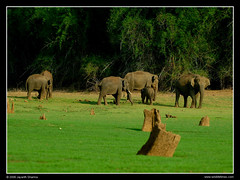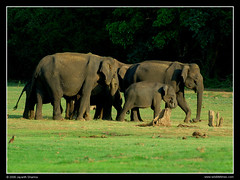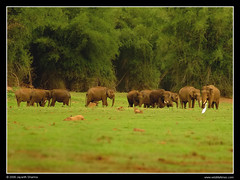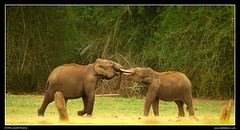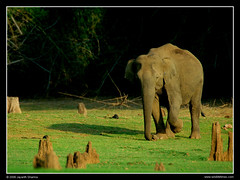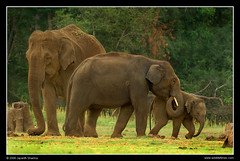Friday, May 27, 2011
முதுமலை வனவிலங்கு காப்பகம்http://tawp.in/r/v1v
கட்டற்ற கலைக்களஞ்சியமான விக்கிப்பீடியாவில் இருந்து.
| முதுமலை தேசியப் பூங்கா முதுமலை புலிகள் உய்வகம் | |
| — தேசியப் பூங்கா — | |
| style="background-color: #CDE5B2; line-height: 1.2;" | IUCN வகை II (தேசிய வனம்) | |
| அமைவிடம் |  11°35′″N76°33′″Eஅமைவு: 11°35′″N76°33′″Eஅமைவு:  11°35′″N 76°33′″E 11°35′″N 76°33′″E |
| நாடு | |
| மாநிலம் | தமிழ் நாடு |
| மாவட்டம் | நீலகிரி மாவட்டம் |
| நிறுவியது | 1940 |
| அருகாமை நகரம் | உதக மண்டலம்(ஊட்டி) 67 கிமீ (42 மை) |
| நேர வலயம் | IST (ஒ.ச.நே.+5:30) |
| பரப்பளவு • உயரம் | 321 ச.கி.மீs (124 sq mi) • 1,266 metres (4,150 ft) |
| தட்பவெப்பம் | Aw (Köppen) • 2,000 mm (79 in) • 33 °C (91 °F) • 14 °C (57 °F) |
தொலைவு(கள்)[காட்டு] | |
| Core of the Nilgiri Biosphere Reserve | Visitors Center atTheppakadu |
| நிர்வாகம் | தமிழ்நாடு வனத்துறை |
| வருநர்கள் 2008 | 100,000+ |
| Entry fee | Rs. 15. per adult (No private vehicles allowed in the Sanctuary) |
| இணையதளம் | Mudumalai Wildlife Sanctuary & National Park (cited) |
Shortcut Codes
Shortcut Codes | Result in Windows XP |
| CTRL and A | Selects all the items in the committed dialogue box. |
| CTRL and C | Copies the item or items to the Clipboard and can be pasted using CTRL and V. |
| CTRL and F | Displays the Find all files dialog box. |
| CTRL and G | Displays the Go to folder dialog box. |
| CTRL and N | Displays the New dialog box. |
| CTRL and O | Displays the Open dialog box. |
| CTRL and P | Displays the Photograph dialog box. |
| CTRL and S | Displays the Save dialog box. |
| CTRL and V | Pastes the copied item or items from the Clipboard. |
| CTRL and X | Cuts the item or items elected to the Clipboard. |
| CTRL and Z | Undoes the last proceedings. |
| CTRL and F4 | Closes the committed document dialogue box. |
| CTRL even as dragging an item | Copy the elected item |
| CTRL+SHIFT with arrow keys | Highlight a check of text |
| CTRL+F4 | Accurate the committed document |
| CTRL+ESC | Sight the Start menu |
| CTRL and F6 | Opens the next document dialogue box in the committed application. |
| ALT+ENTER | View the properties for the elected item |
| ALT+F4 | Accurate the committed item, or quit the committed program |
| ALT+SPACEBAR | Open the shortcut menu for the committed dialogue box |
| ALT+TAB | Thrash between the open items |
| ALT+ESC | Cycle through items in the order that they had been opened |
| F1 key | Gives help on the committed dialogue box or elected item. |
| F2 key | Rename the elected item |
| F3 key | Quest for a file or a folder |
| F4 key | Sight the Address bar list in My Computer or Windows Surveyor |
| F5 key | Update the committed dialogue box |
| F6 key | Cycle through the screen fundamentals in a dialogue box or on the desktop |
| F10 key | Activate the menu bar in the committed program |
| Windows Logo | Sight or hide the Start menu |
| Windows Logo+BREAK | Sight the System Properties dialog box |
| Windows Logo+D | Sight the desktop |
| Windows Logo+M | Minimize all of the windows |
| Windows Logo+SHIFT+M | Restore the minimized windows |
| Windows Logo+E | Open My Computer |
| Windows Logo+F | Quest for a file or a folder |
| CTRL+Windows Logo+F | Quest for computers |
| Windows Logo+F1 | Sight Windows Help |
| Windows Logo+ L | Lock the upright |
| Windows Logo+R | Open the Run dialog box |
| Windows Logo+U | Open Utility Manager |
| TAB | Go forward through the options |
| SHIFT+TAB | Go backward through the options |
| CTRL+TAB | Go forward through the tabs |
| CTRL+SHIFT+TAB | Go backward through the tabs |
| ALT+Underlined epistle | Perform the corresponding mandate or select the corresponding selection |
| ENTER | Perform the mandate for the committed selection or pin |
| SPACEBAR | Select or clear the check box if the committed selection is a check box |
| F1 key | Sight Help |
| F4 key | Sight the items in the committed list |
| Arrow keys | Select a pin if the committed selection is a group of selection buttons |
| BACKSPACE | Open a folder one level up if a folder is elected in the Save As or Opendialog box |
| END | Sight the underneath of the committed dialogue box |
| HOME | Sight the top of the committed dialogue box |
| NUM LOCK+Asterisk sign (*) | Sight all of the subfolders that are under the elected folder |
| NUM LOCK+Plus sign (+) | Sight the contents of the elected folder |
| NUM LOCK+Minus sign (-) | Collapse the elected folder |
| LEFT ARROW | Collapse the current selection if it is expanded, or select the mother folder |
| RIGHT ARROW | Sight the current selection if it is collapsed, or select the first subfolder |
Subscribe to:
Posts (Atom)
